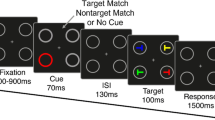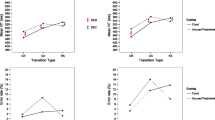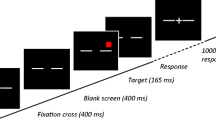Abstract
Advance information about the location of a stimulus (attentional cueing) does not affect the Simon effect (a shortening of manual response times whenever the position of a stimulus that is irrelevant for the task corresponds to the side of the response). However, advance information about the side of a response (intentional cueing) enhances the Simon effect. At first sight, these well-established results contradict two important assumptions about the origin of the Simon effect: (a) the effect originates at least in part in a covert shift of visual attention that forces the preparation of a response towards the location of the attentional shift and (b) interference between stimulus location and response side takes place within a response selection stage. We replicated the behavioral finding in a study that measured event-related potentials (ERPs) of the EEG. ERPs indicated that the mechanisms causing the Simon effect remain widely unaffected by advance information. Clear evidence for both response preparation and attentional shifts in the cue–target interval was found. Additionally, ERPs suggested that the increment of the Simon effect by intentional cueing might be due to perceptual factors rather than to an alteration in the mechanisms involved in the generation of a regular Simon effect. The implications of these data for the role of attention and of response selection in Simon tasks are discussed.





Similar content being viewed by others
Notes
Newton is the unit of force. 2 N corresponds to the weight exerted by a mass of 204 g. This criterion is well within the range used by usual (all-or-none) response devices.
ERLs are difference potentials calculated as the LRP (Coles, 1989; Wascher and Wauschkuhn, 1996) that indicate spatial processing. Contralateral-ipsilateral differences are calculated for all symmetrical electrode pairs by subtracting the EEG activity ipsilateral to the required response from the contralateral activity. Mean differences are calculated separately for left and right responses and subsequently averaged.
All analyses including temporal measures or amplitudes that were derived from peak picking are compared for the two cued conditions only because of the differing EEG-sampling rates in the two experiments.
C1/C2 was selected for the measurement of motor activation since it showed hand-motor activation most purely in a regular 10/10 system. This electrode pair is located over the hand motor areas and close to the electrode positions C3'/C4' as defined by Kutas & Donchin (1980). C3 and C4, which might be an alternative electrode pair to measure the LRP, are in many subjects located behind the central sulcus (see Steinmetz et al., 1989) and therefore more probably affected by the overlap of activity from the parietal cortex (see also Van der Lubbe et al., 2000; Wascher et al., 2001), which might interfere with motor activity if laterally presented stimuli are used.
One might argue that unless subjects are going to respond incorrectly on most invalid trials they have not selected the response based on the intentional cue. There is still a decision to be made, namely to execute the preselected response or to revise it (R. Proctor, personal communication, October, 2002). The crucial point here is how to define response selection. On the one hand, response selection might be defined as the final decision to execute a particular action. In this case, all responses, even in simple response tasks, have to be considered to require response selection. On the other hand, response selection may be defined as the generation or the retrieval of an S–R rule. In this case, subjects may use the selected response in validly cued trials and revise their decision in invalidly cued trials. We refer to the latter definition.
References
Bisiacchi, P., Marzi, C.A., Nicoletti, R., Carena, G., Mucignat, C., & Tomaiuolo, F. (1994). Left-right asymmetry of callosal transfer in normal human subjects. Behavioural Brain Research, 64, 173–178.
Buckolz, E., Odonnell, C., & McAuliffe, J. (1996). The Simon effect: evidence of a response processing ''functional locus''. Human Movement Science, 15, 543–564.
Coles, M.G.H. (1989). Modern mind-brain reading: psychophysiology, physiology, and cognition. Psychophysiology, 26, 251–269.
De Jong, R., Wierda, M., Mulder, G., & Mulder, L.J.M. (1988). Use of partial stimulus information in response processing. Journal of Experimental Psychology: Human Perception and Performance, 14, 682–692.
De Jong, R., Liang, C.-C., & Lauber, E. (1994). Conditional and unconditional automaticity: a dual-process model of effects of spatial stimulus-response correspondence. Journal of Experimental Psychology: Human Perception and Performance, 20, 731–750.
Eason, R.G. (1981). Visual evoked potential correlates of early neural filtering during selective attention. Bulletin of the Psychonomic Society, 18, 203–206.
Eimer, M. (1994). "Sensory gating" as a mechanism for visuospatial orienting: electrophysiological evidence from trial-by-trial cuing experiments. Perception & Psychophysics, 55, 667–675.
Eimer, M. (1995). Stimulus-response compatibility and automatic response activation—evidence from psychophysiological studies. Journal of Experimental Psychology: Human Perception and Performance, 21, 837–854.
Eimer, M. (1996). The N2pc component as an indicator of attentional selectivity. Electroencephalography and Clinical Neurophysiology, 99, 225–234.
Fitts, P.M., & Seeger, C.M. (1953). S-R compatibility: Spatial characteristics of stimulus and response codes. Journal of Experimental Psychology, 46, 199–210.
Gratton, G., Coles, M.G.H., Sirevaag, E.J., Eriksen, C.W., & Donchin, E. (1988). Pre- and poststimulus activation of response channels: a psychophysiological analysis. Journal of Experimental Psychology: Human Perception and Performance, 14, 331–344.
Hasbroucq, T., & Guiard, Y. (1991). Stimulus-response compatibility and the Simon effect: towards a conceptual clarification. Journal of Experimental Psychology: Human Perception and Performance, 17, 246–266.
Hasbroucq, T., & Possamaï, C.A. (1994). What can a precue enhance—an analysis of the experiments of Proctor, Lu and van Zandt (1992). Acta Psychologica, 85, 235–244.
Hillyard, S.A., & Münte, T.F. (1984). Selective attention to color and location: an analysis with event-related brain potentials. Perception & Psychophysics, 36, 185–198.
Hommel, B. (1993). The relationship between stimulus processing and response selection in the Simon task: evidence for a temporal overlap. Psychological Research, 55, 280–290.
Hommel, B. (1996). S-R compatibility effects without response uncertainty. Quarterly Journal of Experimental Psychology Section A: Human Experimental Psychology, 49, 546–571.
Ivanoff, J., & Peters, M. (2000). A shift of attention may be necessary, but it is not sufficient, for the generation of the Simon effect. Psychological Research, 64, 117–135.
Kornblum, S., Hasbroucq, T., & Osman, A. (1990). Dimensional overlap: cognitive basis for stimulus-response compatibility—a model and taxonomy. Psychological Review, 97, 253–270.
Kornhuber, H.H., & Deecke, L. (1965). Hirnpotentialänderungen bei Willkürbewegungen und passiven Bewegungen des Menschen: Bereitschaftspotential und reafferente Potentiale. Pflügers Archiv für die gesamte Physiologie des Menschen und der Tiere, 284, 1–17.
Kramer, A.F., & Hahn, S. (1995). Splitting the beam: distributions of attention over noncontiguous regions of the visual field. Psychological Science, 6, 381–386.
Kutas, M., & Donchin, E. (1980). Preparation to respond as manifested by movement-related brain potentials. Brain Research, 202, 95–115.
LaBerge, D., Carlson, R.L., Williams, J.K., & Bunney, B.G. (1997). Shifting attention in visual space: test of moving-spotlight models versus an activity-distribution model. Journal of Experimental Psychology: Human Perception and Performance, 23, 1380–1392.
Lu, C.-H., & Proctor, R.W. (1995). The influence of irrelevant location information on performance: a review of the Simon and spatial Stroop effects. Psychonomic Bulletin & Review, 2, 174–207.
Luck, S.J. (1995). Multiple mechanisms of visual-spatial attention: recent evidence from human electrophysiology. Behavioural Brain Research, 71, 113–123.
Luck, S.J., & Hillyard, S.A. (1994a). Electrophysiological correlates of feature analysis during visual search. Psychophysiology, 31, 291–308.
Luck, S.J., & Hillyard, S.A. (1994b). Spatial filtering during visual search: Evidence from human electrophysiology. Journal of Experimental Psychology: Human Perception and Performance, 20, 1000–1014.
Luck, S.J., Hillyard, S.A., Mouloua, M., Woldorff, M.G., Clark, V.P., & Hawkins, H.L. (1994). Effects of spatial cuing on luminance detectability: psychophysical and electrophysiological evidence for early selection. Journal of Experimental Psychology: Human Perception & Performance, 20, 887–904.
Mangun, G.R., & Hillyard, S.A. (1987). The spatial allocation of visual attention as indexed by event-related brain potentials. Human Factors, 29, 195–211.
Marzi, C.A., Bisiacchi, P., & Nicoletti, R. (1991). Is interhemispheric transfer of visuomotor information asymmetric? Evidence from a meta-analysis. Neuropsychologia, 29, 1163–1177.
Miller, J., Patterson, T., & Ulrich, R. (1997). A jackknife-based method for measuring LRP onset latency differences. Psychophysiology, 35, 99–115.
Müsseler, J. (1994). Position-dependent and position-independent attention shifts: evidence against the spotlight and premotor assumption of visual focussing. Psychological Research, 56, 251–260.
Nicoletti, R., & Umiltà, C. (1994). Attention shifts produce spatial stimulus codes. Psychological Research, 56, 144–150.
Oostenveld, R., Praamstra, P., Stegeman, D.F., & van Oosterom, A. (2001). Overlap of attention and movement-related activity in lateralized event-related brain potentials. Clinical Neurophysiology, 112, 477–484.
Posner, M.I. (1980). Orienting of attention. Quarterly Journal of Experimental Psychology, 32, 3–25.
Praamstra, P., & Plat, F.M. (2001). Failed suppression of direct visuomotor activation in Parkinson's disease. Journal of Cognitive Neuroscience, 13, 31–43.
Proctor, R.W., & Lu, C.-H. (1994). Referential coding and attention-shifting accounts for the Simon effect. Psychological Research, 56, 185–195.
Proctor, R.W., & Wang, H. (1997). Enhancement of the Simon effect by response-location precues: evaluation of the stimulus-identification account. Acta Psychologica, 95, 279–298.
Proctor, R.W., Lu, C.-H., & Van Zandt, T. (1992). Enhancement of the Simon effect by response precuing. Acta Psychologica, 81, 53–74.
Rubichi, S., Nicoletti, R., Iani, C., & Umiltà, C. (1997). The Simon effect occurs relative to the direction of an attentional shift. Journal of Experimental Psychology: Human Perception and Performance, 23, 1353–1364.
Simon, J.R., & Rudell, A.P. (1967). Auditory S-R compatibility: the effect of an irrelevant cue on information processing. Journal of Applied Psychology, 51, 300–304.
Steinmetz, H., Fürst, G., & Meyer, B.-U. (1989). Craniocerebral topography within the international 10–20 system. Electroencephalography and Clinical Neurophysiology, 72, 499–506.
Stoffer, T.H. (1991). Attentional focussing and spatial stimulus-response compatibility. Psychological Research, 53, 127–135.
Stoffer, T.H., & Umiltà, C. (1997). Spatial coding with reference to the focus of attention in S-R compatibility and the Simon effect. In B. Hommel & W. Prinz (Eds.), Theoretical issues in S-R compatibility (pp. 181–208). Amsterdam: North-Holland.
Stoffer, T.H., & Yakin, A.R. (1994). The functional role of attention for spatial coding in the Simon effect. Psychological Research-Psychologische Forschung, 56, 151–162.
Ulrich, R., & Miller, J. (2001). Using the jackknife-based scoring method for measuring LRP onset effects in factorial designs. Psychophysiology, 38, 816–827.
Umiltà, C., & Liotti, M. (1987). Egocentric and relative spatial codes in S-R compatibility. Psychological Research-Psychologische Forschung, 49, 81–90.
Umiltà, C., & Nicoletti, R. (1990). Spatial stimulus-response compatibility. In R.W. Proctor & T.G. Reeve (Eds.), Stimulus-response compatibility (pp. 89–116). Amsterdam: Elsevier.
Umiltà, C., & Nicoletti, R. (1992). An integrated model of the Simon effect. In J. Alegria & D. Holender (Eds.), Analytic approaches to human cognition (pp. 331–350). Amsterdam: North-Holland.
Valle-Inclán, F. (1996). The locus of interference in the Simon effect: an ERP study. Biological Psychology, 43, 147–162.
Van der Lubbe, R.H.J., & Woestenburg, J.C. (1999). The influence of peripheral precues on the tendency to react towards a lateral relevant stimulus with multiple-item arrays. Biological Psychology, 51, 1–21.
Van der Lubbe, R.H.J., Wauschkuhn, B., Wascher, E., Niehoff, T., Kompf, D., & Verleger, R. (2000). Lateralized EEG components with direction information for the preparation of saccades versus finger movements. Experimental Brain Research, 132, 163–178.
Verfaellie, M.D., Bowers, D., & Heilman, K.M. (1988). Attentional factors in the occurrence of stimulus-response compatibility effects. Neuropsychologia, 26, 435–444.
Verleger, R., Gasser, T., & Möcks, J. (1982). Correction of EEG artifacts in event-related potentials of the EEG: aspects of reliability and validity. Psychophysiology, 19, 472–480.
Verleger, R., Vollmer, C., Wauschkuhn, B., Van der Lubbe, R.H.J., & Wascher, E. (2000). Dimensional overlap between arrows as cueing stimuli and responses? Evidence from contra-ipsilateral differences in EEG potentials. Cognitive Brain Research, 10, 99–109.
Vogel, E.K., & Luck, S.J. (2000). The visual N1 component as an index of a discrimination process. Psychophysiology, 37, 190–203.
Wascher, E., & Wauschkuhn, B. (1996). The interaction of stimulus- and response-related processes measured by event-related lateralizations of the EEG. Electroencephalography and Clinical Neurophysiology, 99, 149–162.
Wascher, E., Schatz, U., Kuder, T., & Verleger, R. (2001). Validity and boundary conditions of automatic response activation in the Simon task. Journal of Experimental Psychology: Human Perception and Performance, 27, 731–751.
Yantis, S., & Jonides, J. (1990). Abrupt visual onsets and selective attention: voluntary versus automatic allocation. Journal of Experimental Psychology: Human Perception and Performance, 16, 121–134.
Zimba, L.D., & Brito, C.F. (1995). Attention precuing and Simon effects—a test of the attention coding account of the Simon effect. Psychological Research-Psychologische Forschung, 58, 102–118.
Acknowledgements
We would like to thank Carlo Umiltà, Robert Proctor, and an anonymous reviewer for their constructive comments on earlier drafts of this paper. This study was supported by grants from the Deutsche Forschungsgemeinschaft to Edmund Wascher (Wa 987/ 5–1).
Author information
Authors and Affiliations
Corresponding author
Rights and permissions
About this article
Cite this article
Wascher, E., Wolber, M. Attentional and intentional cueing in a Simon task: An EEG-based approach. Psychological Research 68, 18–30 (2004). https://doi.org/10.1007/s00426-002-0128-z
Received:
Accepted:
Published:
Issue Date:
DOI: https://doi.org/10.1007/s00426-002-0128-z




